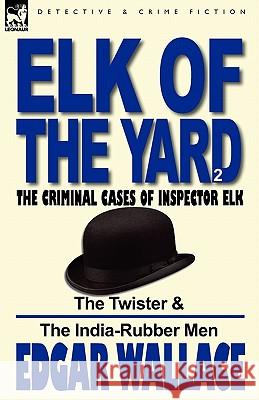Elk of the 'Yard'-The Criminal Cases of Inspector Elk: Volume 2-The Twister & the India-Rubber Men » książka
Elk of the 'Yard'-The Criminal Cases of Inspector Elk: Volume 2-The Twister & the India-Rubber Men
ISBN-13: 9780857065667 / Angielski / Miękka / 2011 / 400 str.
Elk of the 'Yard'-The Criminal Cases of Inspector Elk: Volume 2-The Twister & the India-Rubber Men
ISBN-13: 9780857065667 / Angielski / Miękka / 2011 / 400 str.
(netto: 96,46 VAT: 5%)
Najniższa cena z 30 dni: 96,06
ok. 16-18 dni roboczych.
Darmowa dostawa!
The criminal cases of Inspector Elk-six novels in three volumes
There was a time, nostalgically familiar from the black and white British movies made from the late 1930s to the mid-1950s, when the detectives of the C. I. D, the men from Scotland Yard in plain clothes, were as recognisable to audiences as they were to the criminals they pursued. They were perennially portrayed as big, dour, doggedly stubborn men dressed in shabby and poorly fitting suits over which they wore a 'never to be buttoned' overcoat or trench style waterproof. To crown this effect each wore a squarely positioned black bowler or derby hat. All stereotypes have a foundation in fact and most certainly in fiction, for this is the description of the principal character of this special three volume Leonaur collection of detective fiction, featuring the complete cases of Detective Sergeant-soon to be Detective Inspector-Elk of the Yard. His creator, British author Edgar Wallace, was a prolific writer responsible for a number of memorable characters, among them the unforgettable J. G. Reeder, the Four Just Men and the Colonial administrator Sanders (whose exploits are all available as Leonaur collections), whose purpose was to bring the criminal class to their just desserts. Elk is less well-known and in him we have a different breed of 'hero.' Here is the detective for everyman, the kind of work-a-day 'copper' that all of Wallace's audience would recognise. Elk is the policeman who in stories of more exotic detectives is a figure of fun, but who always pursues his quarry until, through the application of solid 'police-work, 'he gets his man.
This second volume finds Inspector Elk engaged in the story of 'The Twister' and in a second outing, the fourth in this series, 'The India-Rubber Men.'
Leonaur editions are newly typeset and are not facsimiles; each title is available in softcover and hardback with dustjacket; our hardbacks are cloth bound and feature gold foil lettering on their spines and fabric head and tail bands.
The criminal cases of Inspector Elk-six novels in three volumes
There was a time, nostalgically familiar from the black and white British movies made from the late 1930s to the mid-1950s, when the detectives of the C. I. D, the men from Scotland Yard in plain clothes, were as recognisable to audiences as they were to the criminals they pursued. They were perennially portrayed as big, dour, doggedly stubborn men dressed in shabby and poorly fitting suits over which they wore a never to be buttoned overcoat or trench style waterproof. To crown this effect each wore a squarely positioned black bowler or derby hat. All stereotypes have a foundation in fact and most certainly in fiction, for this is the description of the principal character of this special three volume Leonaur collection of detective fiction, featuring the complete cases of Detective Sergeant-soon to be Detective Inspector-Elk of the Yard. His creator, British author Edgar Wallace, was a prolific writer responsible for a number of memorable characters, among them the unforgettable J. G. Reeder, the Four Just Men and the Colonial administrator Sanders (whose exploits are all available as Leonaur collections), whose purpose was to bring the criminal class to their just desserts. Elk is less well-known and in him we have a different breed of hero. Here is the detective for everyman, the kind of work-a-day copper that all of Wallaces audience would recognise. Elk is the policeman who in stories of more exotic detectives is a figure of fun, but who always pursues his quarry until, through the application of solid police-work,he gets his man.
This second volume finds Inspector Elk engaged in the story of The Twister and in a second outing, the fourth in this series, The India-Rubber Men.
Leonaur editions are newly typeset and are not facsimiles; each title is available in softcover and hardback with dustjacket; our hardbacks are cloth bound and feature gold foil lettering on their spines and fabric head and tail bands.











